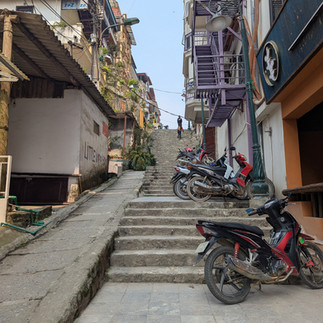Sapa, Vietnam
- Katy Lillich

- Mar 23
- 3 min read
Natural beauty, local culture and the highest peak in Indochina
When I headed up to Sapa,I thought I was going to a peaceful place in nature. That was partially true... The views of the mountains and fields are awesome but it's also a bustling city.
My hotel was located a few streets down from the city, which made it a bit quieter, and also meant that going to the main streets was a walk up a steep hill. I'm really getting my steps in here, that's for sure!
Sapa lights up at night!

I did a batik class with a local h'mong woman named Zen. She had solid block made of a mixture wax and honey, which she shaved into a small bowl that was melted over burning charcoal . Then you use a metal tipped tool to apply it to hemp fabric which has the design stenciled out in pencil with a metal tipped tool. After the design is complete, you dye it in indigo and wash in hot water to remove the wax and pencil markings. We didn't do the dye in the class, but she gave me the indigo powder to take home. (Hopefully that's not an issue at any of the airports...?)
From sapa you can take a short train ride to Farsipan Sun ... Where you take one of the longest cable cars to the top of highest peak in Indochina. 10,326 ft. It is the highest mountain on the Indochinese peninsula (comprising Vietnam, Laos, and Cambodia), nicknamed "the Roof of Indochina". There is a cable car to the peak that opened in 2016. The gondola lift takes twenty minutes to reach the summit. The service holds two Guinness World Records for the longest nonstop, three-rope cable car in the world, spanning 3.9 miles (!!), and the greatest elevation difference by a nonstop, three-roped cable car for the 4,626 ft difference in elevation between the termini. From the end of the cable car you still have to climb hundred of steps to get to the peak. The whole round trip, including visiting several Buddhist temples, the giant seated Buddha and walking through the disney-esque exhibit about the local minority ethnic groups took about three hours.
I did a trek with a local h'mong guide and a group of other travelers through the terraced farm land, where they grow rice and corn, visiting two ethnic minority villages along the way. The guide, Chan, told us about the villages and about her life there. She learned English by selling to tourists, as so many women (and children) do there.
Delicious food
I picked my hotel room based on this tub with a view of the valley, and it didn't disappoint, especially after the hike!

It wasn't all beautiful scenery.... There are also some insights that are less pleasant. The ladies from the villages are the most aggressive sellers of any I've encountered anywhere (!). On the first day, walking around the city, I told one woman that I wasn't buying, but then another showed me a pair of simple, silver hoops that I liked so I bought them. The first woman found me and followed me for a full block saying 'why you tell me no, then buy from her?? Not fair!', over and over. I learned quickly to say, no thank you and just turn away. Even if wanted to I couldn't buy something from all of them.
The women in the view of the hike followed our group for about two hours. The oldest woman kept offering to show me where to step or offering her hand if we were climbing over water or large steps. At the rest stop she walked up to me and said, 'you pay me now!'.
















































Comments